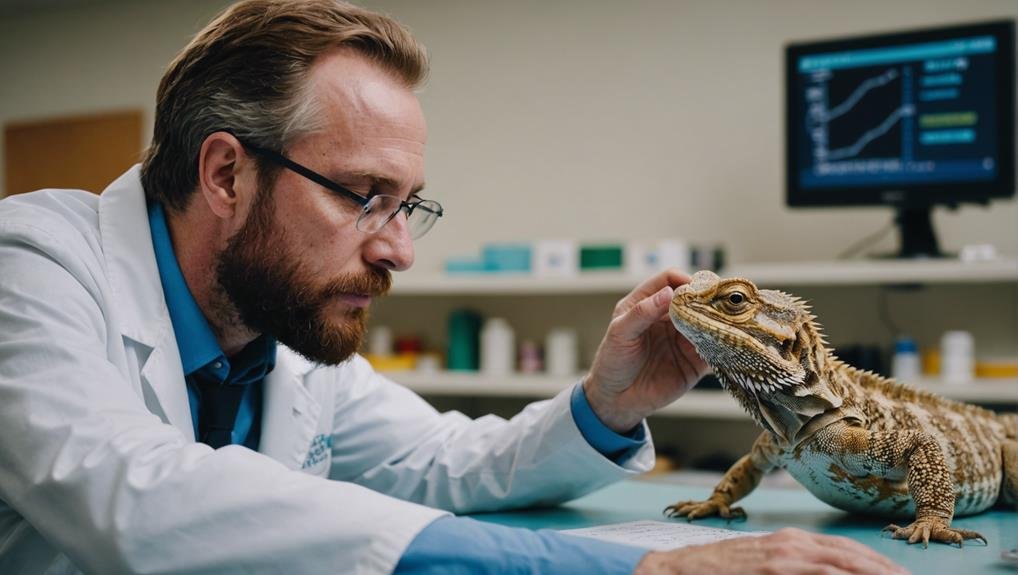When you notice your bearded dragon showing signs of lethargy or a sudden loss of appetite, it’s important to take immediate action. These symptoms can be early indicators of more serious health issues that, if left unchecked, might lead to severe consequences. Ensuring your pet’s environment replicates its natural habitat with proper heat, light, and nutrition is vital. But what if you’ve done all this, and your bearded dragon still shows worrying signs? Understanding the subtler signals of distress and the measures you can take to intervene could mean the difference between recovery and a far grimmer outcome. What steps should you take next, and how can you ensure you’re not missing anything critical in your pet’s care? Learn about Bearded Dragon Death Signs and How These Can Be Avoided.
Key Takeaways
- Monitor for lethargy and inactivity, ensuring optimal enclosure temperature and hydration.
- Watch for loss of appetite, which may indicate metabolic issues or stress.
- Recognize respiratory distress signs like gasping and unusual breathing sounds and seek immediate veterinary care.
- Observe any behavioral changes such as increased aggression or altered sleep patterns.
- Check for physical appearance red flags like skin discoloration and abnormal shedding.
Identifying Lethargy and Inactivity
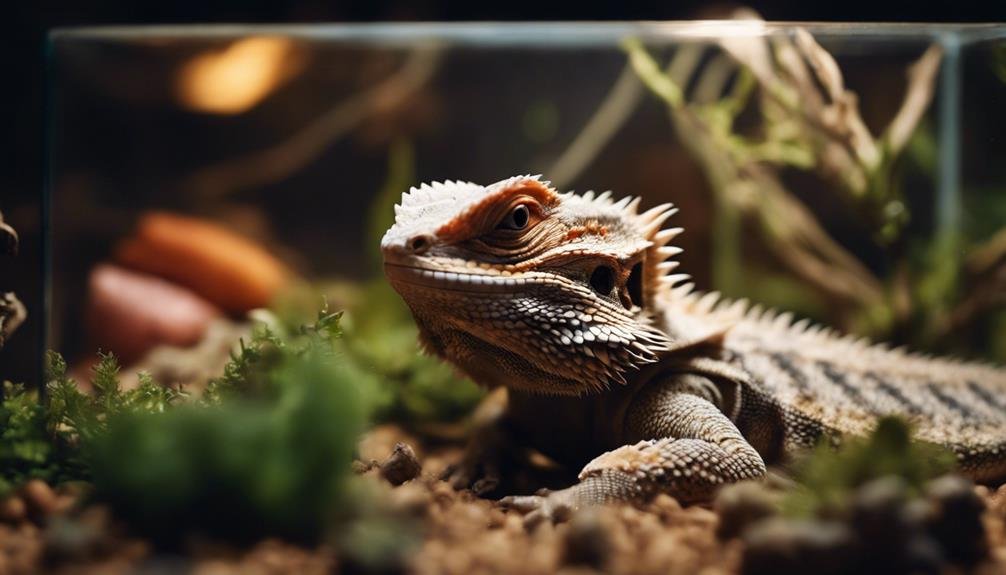

Observing your bearded dragon, you might notice periods of inactivity, which could signal underlying health issues. It’s important to assess their environment, especially factors like temperature regulation and hydration levels, which greatly impact their well-being.
Bearded dragons require a specific range of temperatures to stay active and healthy. If the temperature in their habitat is too low, they can become lethargic. You’ll want to ensure their basking area is between 95-110°F during the day and the cooler part of their tank stays around 75-85°F. At night, temperatures can drop a bit but should remain above 65°F. A reliable digital thermometer will be used to monitor these conditions closely.
Hydration is another critical factor. Dehydration can also lead to lethargy. Ensure you’re providing a shallow water dish and regularly misting their enclosure. Observe if they’re drinking or showing signs of dehydration like sunken eyes or dry, flaky skin.
Consider a vet visit if you’ve optimized temperature and hydration but your bearded dragon remains inactive. Early detection of potential health issues can prevent more severe complications and keep your scaly friend lively and healthy.
Loss of Appetite Causes
While addressing lethargy in your bearded dragon, you might also notice a decreased appetite, which can stem from various causes. One primary factor could be metabolic issues. These often involve imbalances such as calcium deficiency or metabolic bone disease, directly affecting your pet’s desire to eat. Monitoring and adjusting their nutrient intake is essential to manage these conditions.
Environmental stress is another significant factor that could lead to loss of appetite. Your bearded dragon is sensitive to changes in its habitat. If the temperature is too low or too high or the lighting is inadequate, it may feel stressed and refuse to eat. It is important to maintain a consistent and suitable environment that mimics its natural habitat as closely as possible.
Additionally, the setup of their enclosure plays a role. Ensure it’s spacious enough with proper hiding spots and climbing opportunities, as a cramped or barren enclosure can lead to stress. Regularly cleaning the habitat to prevent buildup and waste is also necessary to keep your bearded dragon healthy and comfortable.
If you’ve addressed these issues and your bearded dragon’s appetite doesn’t improve, it’s advisable to consult a vet to rule out any underlying health problems.
Signs of Respiratory Distress
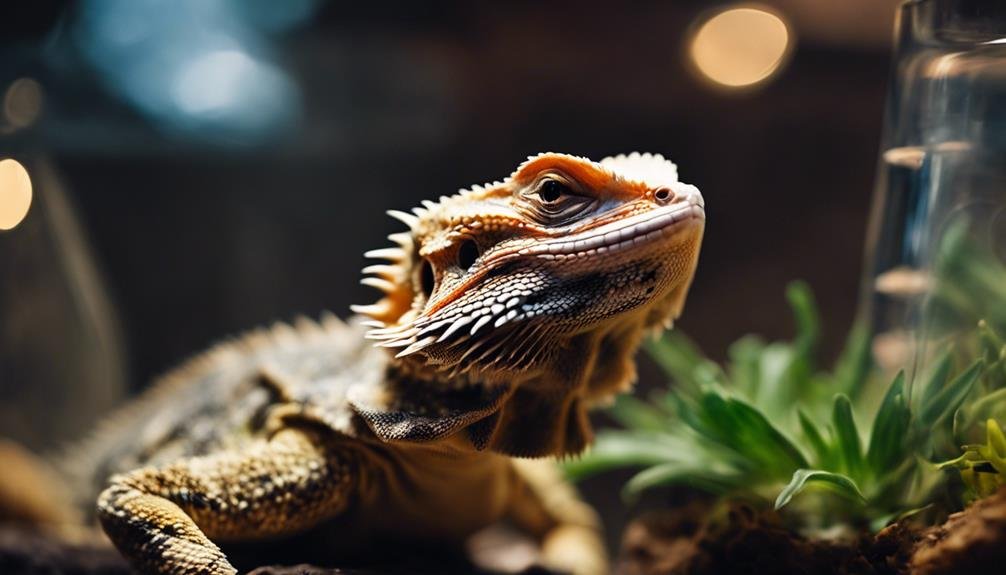

Have you noticed your bearded dragon gasping for air or producing unusual breathing sounds? These are alarming signs that your pet might be experiencing respiratory distress. When a bearded dragon struggles with respiratory health, mouth gaping often occurs. This isn’t just your dragon trying to cool down; it’s a critical attempt to catch more air. You might also observe an increased effort in their breathing, where their whole body seems to heave with each breath.
Another telltale sign to watch for is nostril discharge. If you see mucus or any abnormal secretions around their nostrils, it strongly indicates respiratory issues. Such symptoms shouldn’t be taken lightly, as they can escalate quickly.
Don’t wait until these symptoms worsen. Respiratory infections in bearded dragons can stem from various causes, including poor habitat conditions like low temperatures or high humidity. Ensuring their environment is well-regulated with proper heat and humidity levels is essential. Regular cleaning to prevent buildup and mold is crucial in keeping your bearded dragon healthy. If you’re seeing any of these signs, immediately consult a veterinarian experienced with reptiles.
Behavioral Changes to Monitor
Are you noticing sudden changes in your bearded dragon’s usual behavior or activity levels? Paying close attention is important, as these could be warning signs. One key indicator to watch for is an increase in aggression. If your typically calm bearded dragon starts showing unprovoked aggression or becomes more irritable, it might be a sign that something’s wrong. This behavior could stem from pain, discomfort, or stress requiring immediate attention.
Another significant aspect to monitor is their sleep patterns. Bearded dragons typically have a set routine when it comes to sleep. If you observe that your pet is sleeping more than usual or shows difficulty in maintaining a regular sleep cycle, this could indicate health issues. Disruptions in sleep patterns can be a response to various internal problems, ranging from metabolic to neurological issues.
It’s essential to keep a detailed record of these behavioral changes. Discuss any shifts in aggression or sleep habits with your vet. Early detection and intervention can make a significant difference in managing potential health problems, ensuring your bearded dragon stays healthy and happy.
Physical Appearance Red Flags
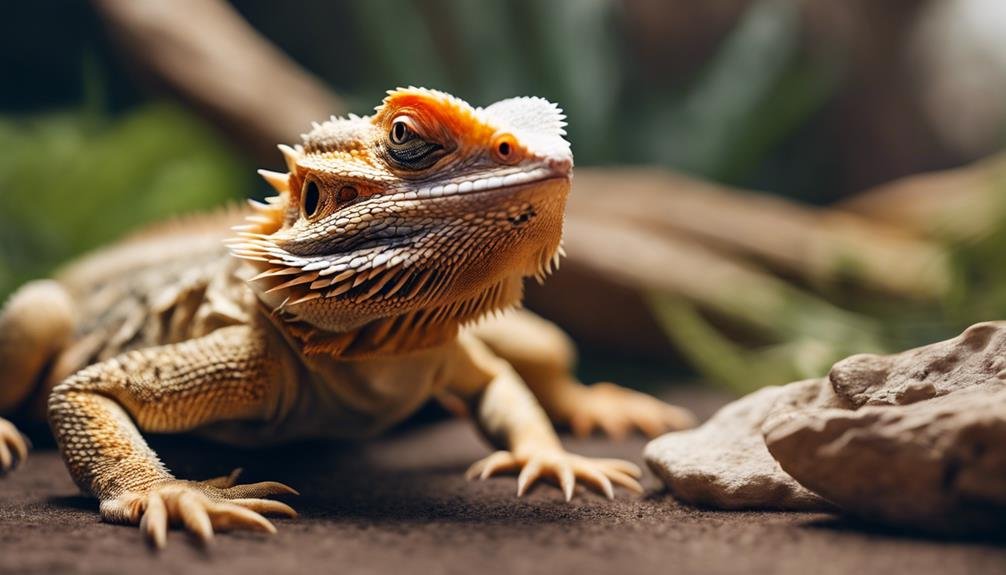

Monitor your bearded dragon for any skin texture or color changes, which can signal underlying health issues. You’ll also want to watch for any signs of skin discoloration. It could be a sign of stress, poor diet, or even disease if you notice unusually lighter or darker patches than the normal color. Skin that appears yellowish might indicate jaundice, a serious liver issue.
Abnormal shedding is another red flag to watch for. Bearded dragons typically shed their skin in large, even pieces. However, if you see patchy shedding or areas where the skin doesn’t shed, it’s a cause for concern. This could be due to dehydration, nutritional deficiencies, or infection. The skin left behind can tighten and constrict circulation, leading to further complications.
Ensure you’re observing how these skin issues correlate with other symptoms like lethargy or loss of appetite. These combined signs can help you catch health problems early. Remember, your bearded dragon’s skin is a big indicator of their overall health, so don’t overlook these critical signs.
Preventive Health Measures
To safeguard your bearded dragon’s health, it’s important to implement a routine of preventative care measures. Proper habitat setup and nutritional advice are key components of this care.
Firstly, let’s talk about habitat setup. Guarantee your bearded dragon’s environment mimics its natural habitat to reduce stress and potential health issues. This means maintaining appropriate temperature gradients in the enclosure—hot spots around 95-110 degrees Fahrenheit and cooler areas about 75-85 degrees Fahrenheit. UVB lighting is non-negotiable; it helps them synthesize vitamin D3, which is necessary for calcium absorption and overall health. Regularly clean the enclosure to prevent build and replace substrates as needed.
Moving on to nutritional advice, a balanced diet is important. Bearded dragons need a mix of vegetables, fruits, and insects. Staple greens like collard, mustard, and turnip greens should be part of their daily diet. For protein, offer crickets, mealworms, or dubia roaches, but ensure these are gut-loaded (fed nutritious foods) to pass those benefits on to your pet. Calcium and vitamin supplements are also crucial to prevent metabolic bone disease, but be careful with the dosage to avoid toxicity.
Emergency Response Tips
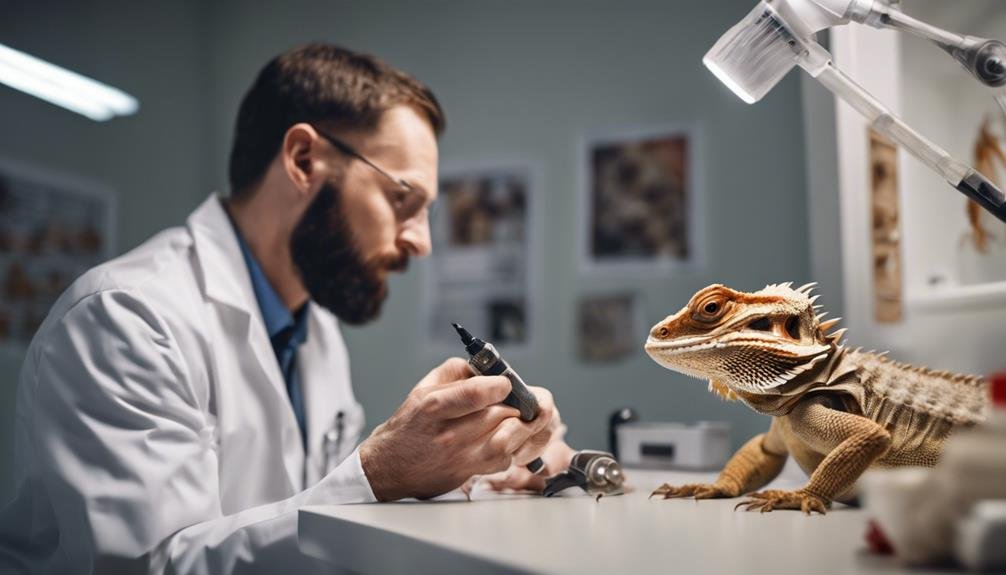

If your bearded dragon shows sudden distress, it’s important to act quickly to address the emergency. First, assess their environment for any immediate hazards, particularly focusing on heat management. Bearded dragons require a specific temperature range to thrive—between 75 and 110 degrees Fahrenheit. You must adjust it promptly if the temperature is too low or too high. Use a reliable thermometer to check the habitat’s temperature at different points to ensure it’s evenly heated.
Next, perform hydration checks. Gently pinch your dragon’s skin; if it doesn’t snap back quickly, they might be dehydrated. Offer water by dripping it on their nose with a dropper or syringe, as they often won’t drink from a bowl. Monitor their response and make sure they’re ingesting the water.
If these steps don’t alleviate their distress, contacting a vet specializing in reptiles is important. Describe the symptoms and any actions you’ve taken. Quick and precise action can differentiate between recovery and a more serious outcome. Keep your vet’s emergency number handy and know the fastest route to their clinic. Your preparedness could save your pet’s life.
Conclusion
As a bearded dragon owner, staying vigilant about your pet’s health is essential. Watch for lethargy, appetite loss, respiratory issues, behavioral shifts, and physical changes.
Guarantee their habitat has correct temperatures, UVB light, and a nutritious diet. Regularly monitor and consult your vet promptly if you spot warning signs.
Taking these preventative measures and responding quickly to any distress will greatly enhance your bearded dragon’s chances for a long, healthy life.

